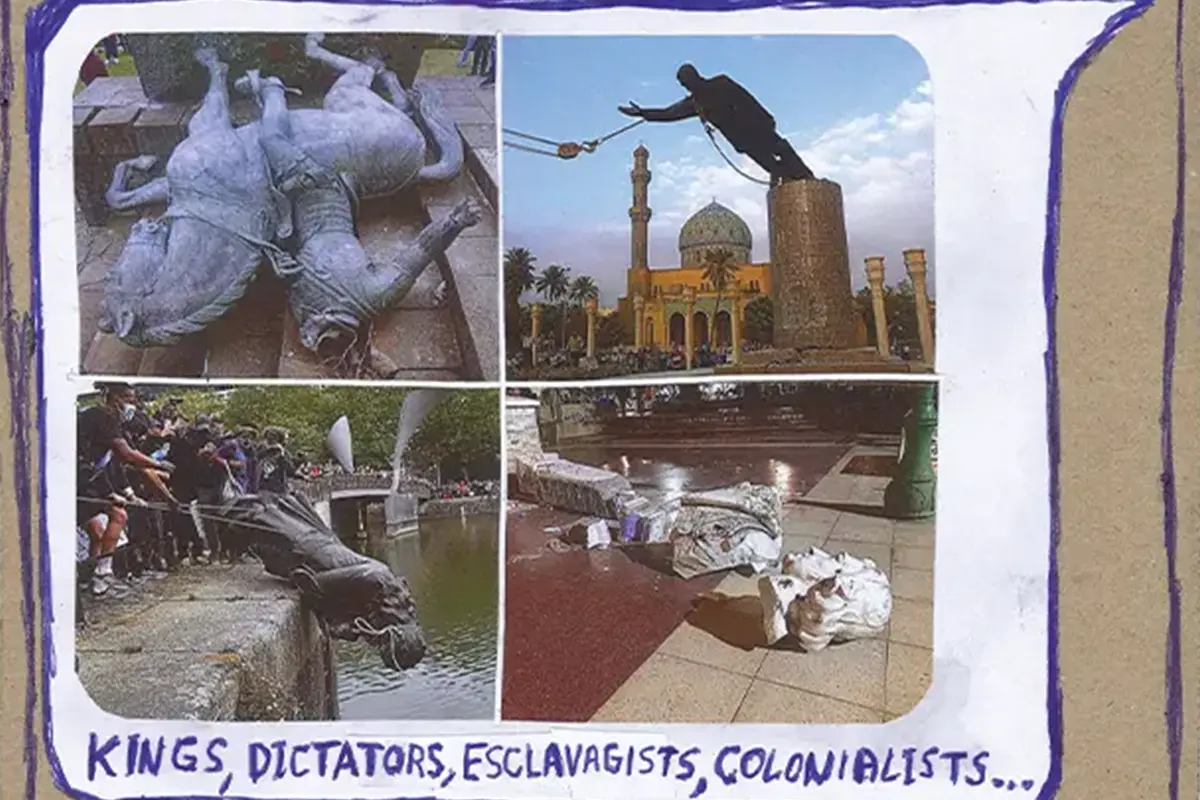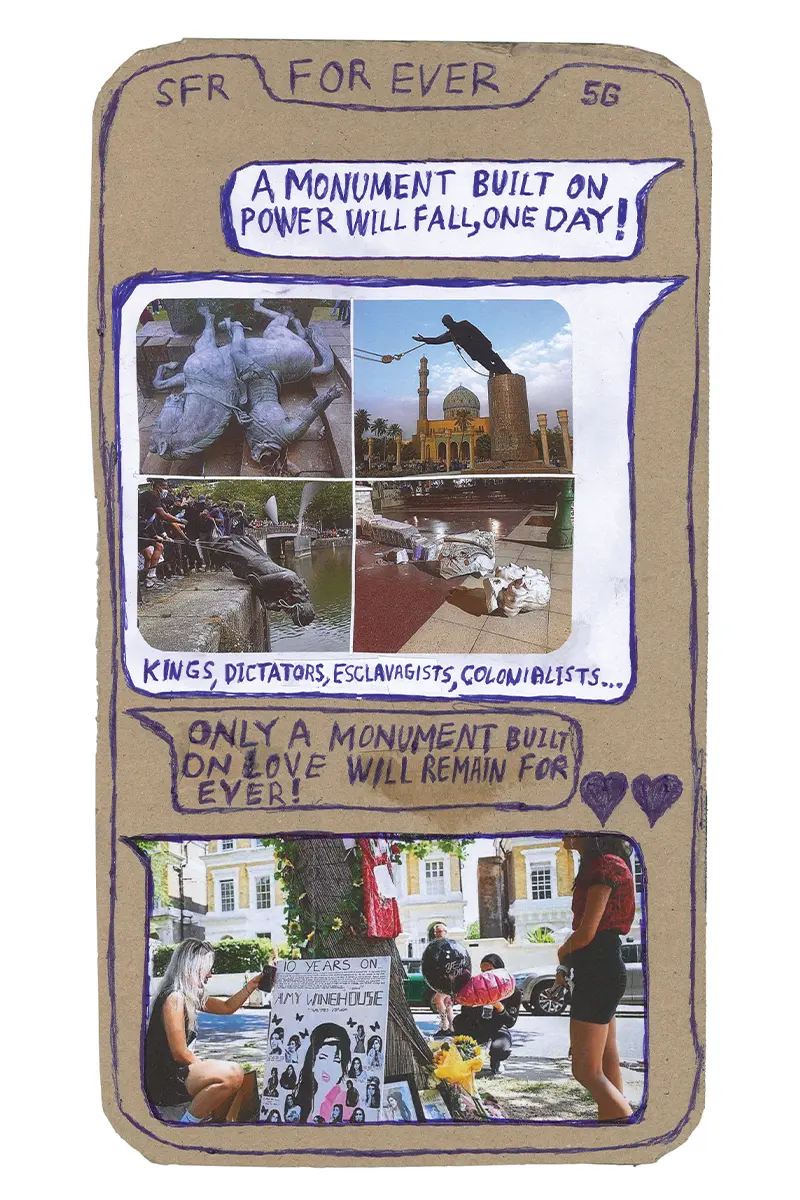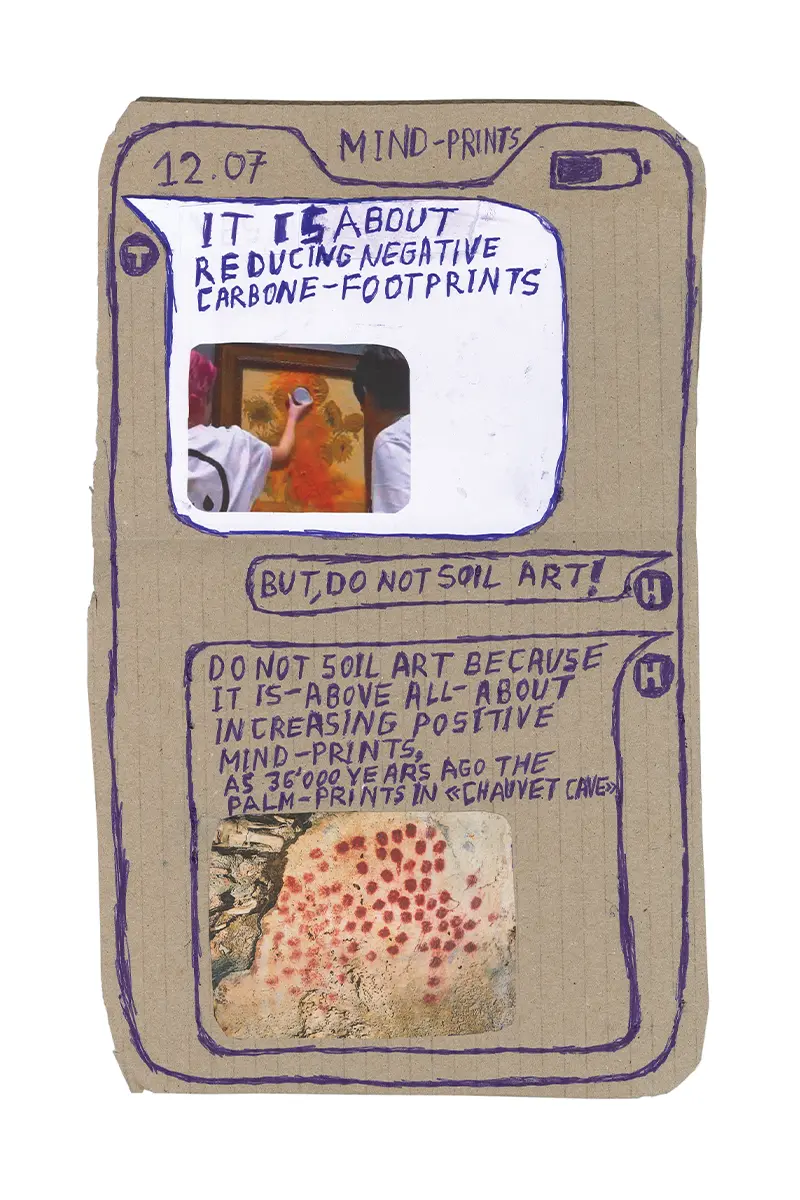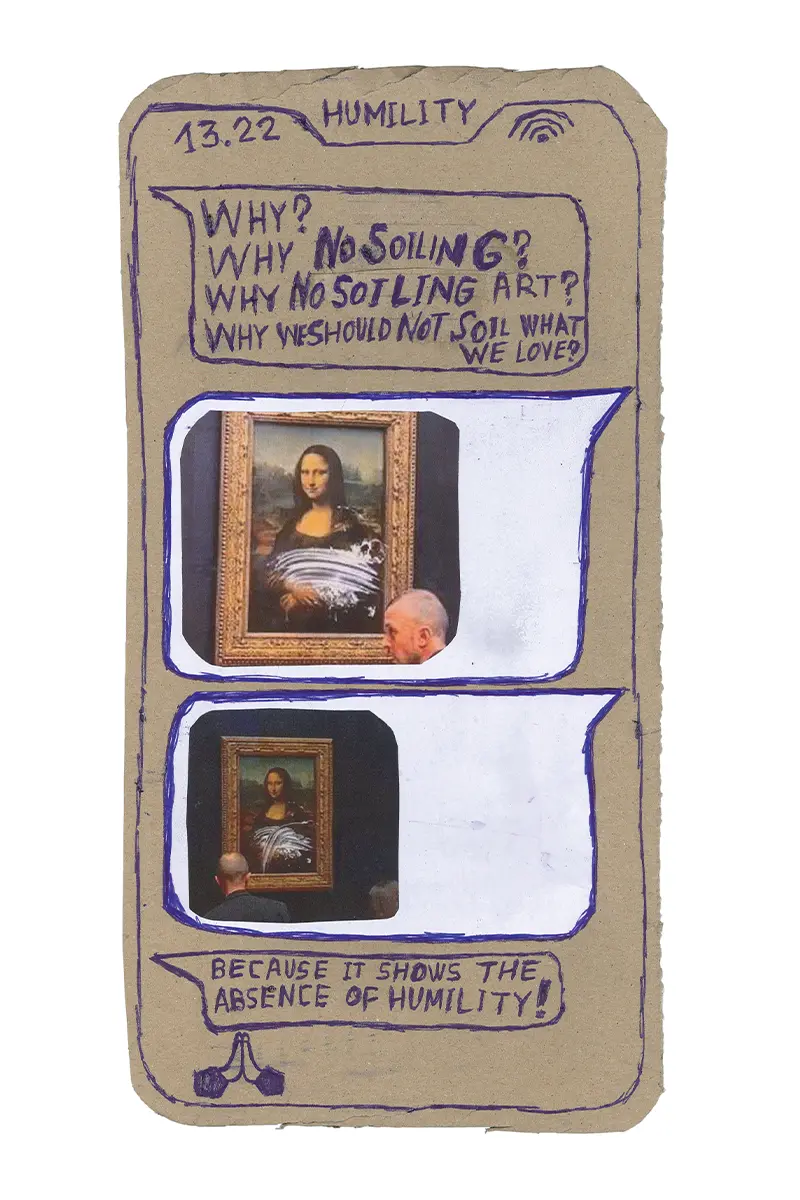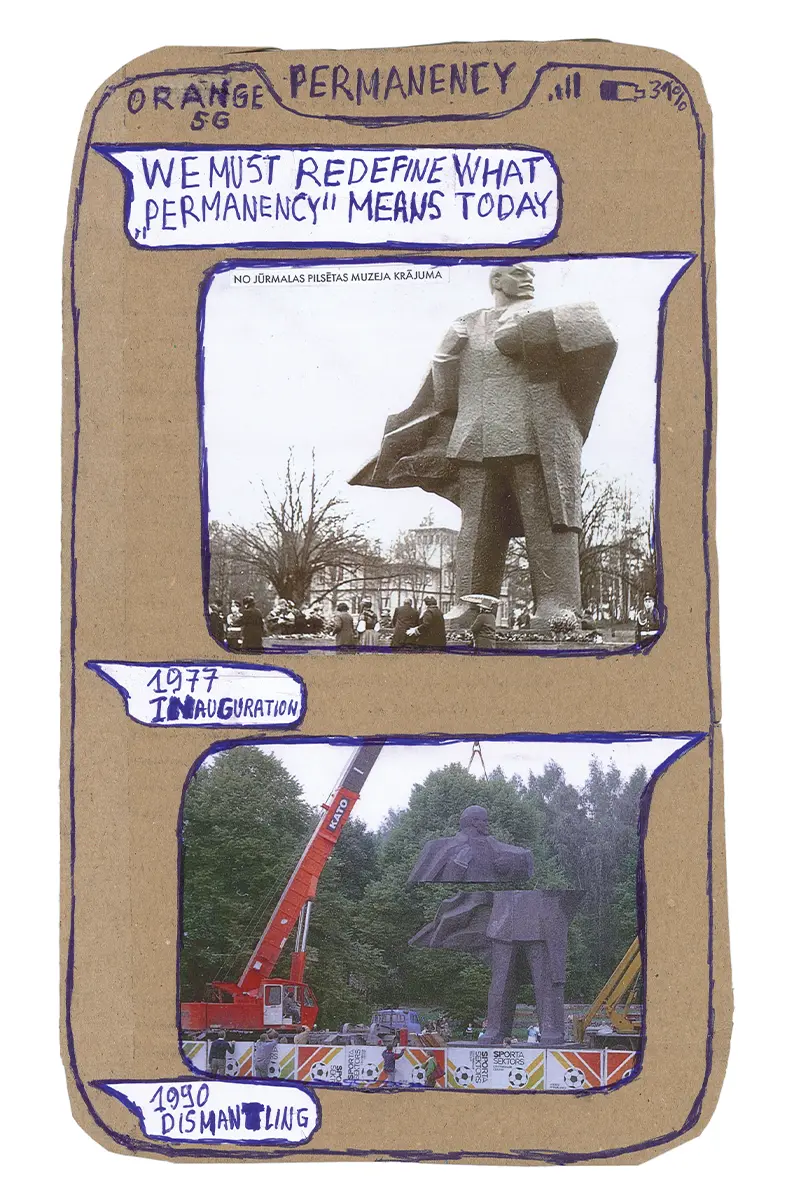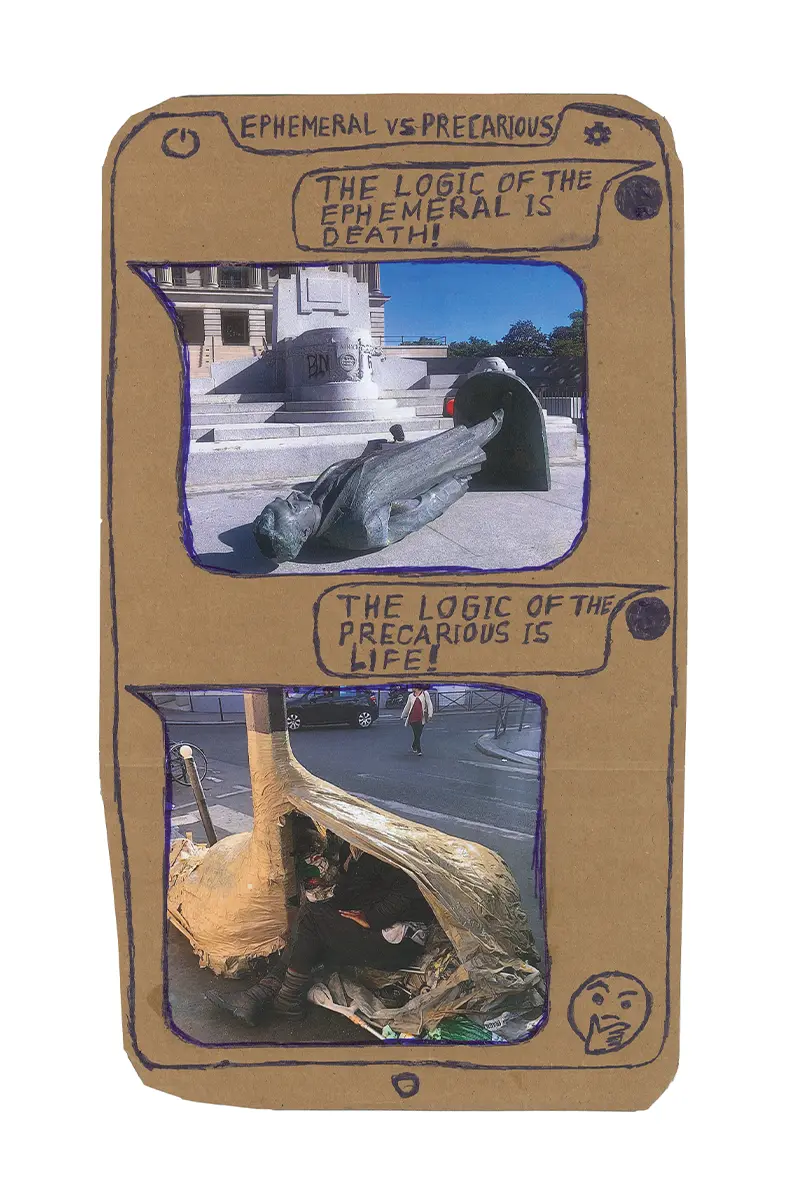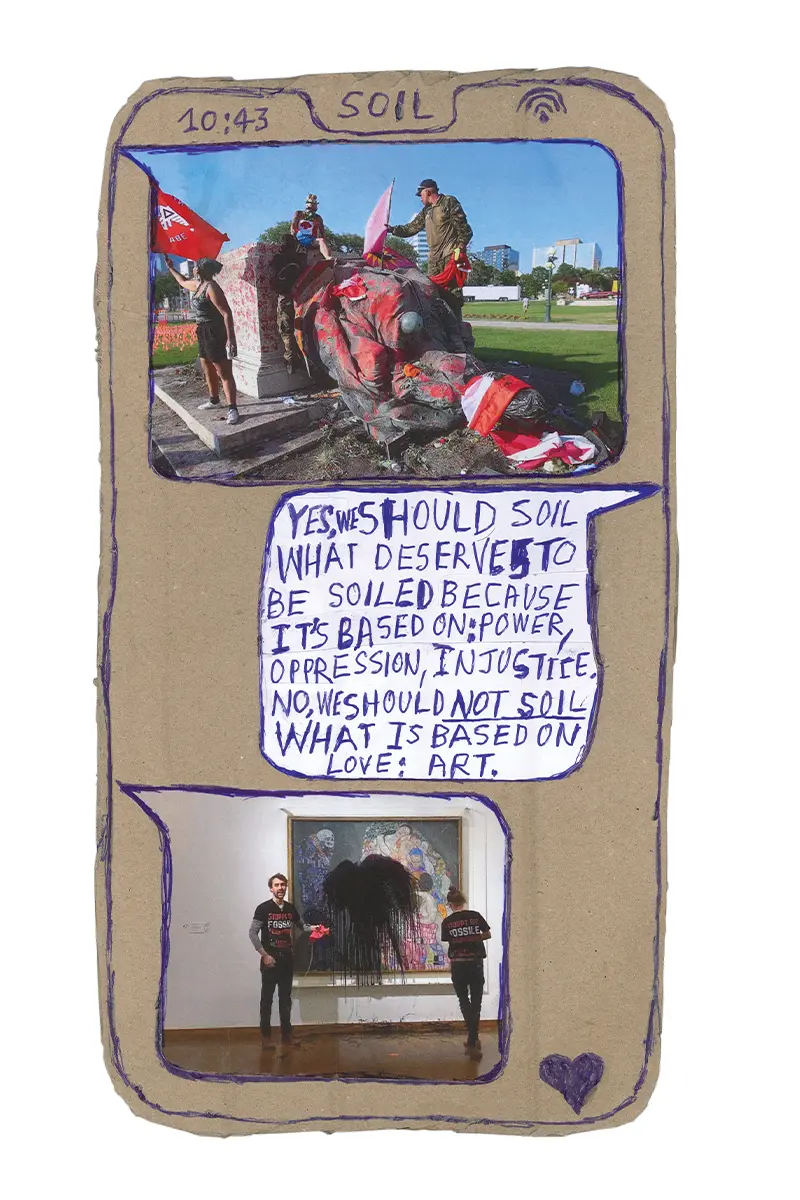«Art is a tool. As an artist I need to see with my own eyes, think with my own brain, in all circumstances even when global events affect me» – Thomas Hirschhorn
The Swiss artist Thomas Hirschhorn
Thomas Hirschhorn is a Swiss artist known for his large-scale installations that often feature found objects, collage, and text. His work has been described and identified by sharp irony used to criticize political content and encourage engagement with social issues in a humorous way:
«I am hoping that there is some humor or self-irony in my work. Because if somebody laughs about my work, or myself – which I can understand since I often feel ridiculous facing my own work – this is a sign of inclusion and universality». The artist focuses on themes such as violence, conflict, and inequality in his art, using a variety of mediums including sculpture, drawing, and video.
In 2022, while Ukraine was fighting the Russian invasion, and while the Venice Biennale was opening, Hirschhorn was working in Dubulti, Latvia, on the Art Shelter project, a shelter for hope and dialogue with lectures, workshops, discussions and artworks.
Thomas Hirschhorn: Art as a tool in the toolbox
How would Thomas Hirschhorn describe his own work? Thomas Hirschhorn’s answer includes the use of everyday materials: recycled cardboard, tyres, gaffer tape. As the artist describes: «I do sculptural work. By ‘sculptural’ I mean that I give form from the 2nd dimension into the 3rd dimension, without caring about the question of volume. My work creates a relation with the world surrounding me, it permits me to have contact with the time I am living in and allows me to confront the reality which is mine».
Thomas Hirschhorn ‘s art often engages with contemporary issues, such as politics, the environment, and social justice. He keeps explaining and comments on: «Art is therefore a tool, a tool I love to use. It is difficult to say, myself, if my work has evolved. To me it has evolved because if not, then why continue? I can understand that someone judges my work as always, the same. I don’t mind this judgment, and live and work with it since I know that the inside is the outside, and that the outside is the inside. And besides, as the artist, I need to insist on the form of my work – and in doing so, I want my work to be persistent».
Critical thinking on contemporary society
Hirschhorn lives and works in Paris, he loves writing about his work and even more to read books, valuable tools for his work and living. In 2014 he made a list explaining the role of readings in his life: bookshelves are always non-finished, non-complete, never accomplished – so they are a never-ending work – and, in addition, a source of inspiration because books help you question yourself:
«My sources are all kinds of forms which interrogate me today. How are different kinds of things produced or performed: texts, words, images, movements, sounds. Beautiful or horrific. My sources can be questions of Injustice or claims for Truth. Something ‘fake’ or something with a soul can be an inspiration to work».
Since the mid-1980s Hirschhorn’s art is a critical thinking on contemporary society. As shown in the work ‘Concordia, Concordia’, installed at the Gladstone Gallery in 2012 and inspired by the shipwreck of an Italian cruise ship, Thomas Hirschhorn is often inspired also by destruction:
«There are so many things in this world, in our world, in our unique world which nourish and fuel my work. Because it is based on the technique of collage, a huge amount of elements can be a source or an influence for my work. To clarify, an inspiration is always something that only I see as such or understand as I do. As an artist I need to see with my own eyes, think with my own brain, in all circumstances even when global events affect us/me. Nobody must agree with me, because it’s about my very own, even when being free with what’s my own is a challenge».
Art as an asset of social interest in Thomas Hirschhorn’s work
Thomas Hirschhorn creates ephemeral and temporary installations from mundane materials, works for which he enlists and engages individuals who live close to the places where the works will be set up.
«Ideology is banned from my work. If something has a role in my work, it is art and the history of art. Never have I called myself a ‘political artist’ or an ‘engaged artist’, just because every artist must be completely engaged with her/his art and because every art is ‘political’. Often there is confusion concerning ‘politics’ in the language about art and, as every artist, I need – in order to do my work – to hold a position, I don’t need ‘politics’».
During the Covid pandemic, the artist staged a small exhibition in front of his Paris studio for over two months to protest against the pandemic restrictions that have qualified art and art institutions as social entertainment and not a necessity.
«My problem is: how can I make a work which, in all cases, resists facts? How can I do a work of art that reaches beyond history – the history I am living in? And how can I – in my historical field, today – do an ‘A-historical’ work? If I can achieve throughout my work, to answer those questions, then it means: ‘Working politically’».
I learn from you, you learn from me – Thomas Hirschhorn
The question to ask to begin any work is always one, and not surprisingly it was also the title of a critical-workshop which took place in Saskatoon, Canada, in 2018: ‘What can I learn from you? What can you learn from me?’
«I am doing art, I am not doing ‘political art’, ‘community art’, or ‘educational art’. My experience of art – art in the history of art – is what influenced me as an artist. Thanks to this experience of art, I established a relationship with the world. Experiencing something is personal but it’s only by sharing it universally that it acquires a value. This sharing of a personal experience has value if I can give it a form which includes the other, the viewer, the audience. And this is the problem, my problem, as an artist: how can I take a position? How can I give form – a universal form – to this position? How can I do an artwork which implicates the other with my very own experience? I always had to – and still must fight for my work, for my position, for my understanding of art. I am not complaining because it’s about fighting ‘for’ – it’s always ‘for’. I never fight ‘against’, against another work, another understanding of art, or against another position».
This approach always involves a certain response: everyone can learn something from the Other and everyone can teach the Other something specific: presence, dialogue, provocation. Among the responsibilities of an artist, there is indeed the awareness of the impact that his or her art and actions can have on others. «I am – as an artist – an activist, a social activist. My activism is to do a work of art. I am an artist, worker, soldier».
Love, Aesthetics, Politics and Philosophy
«My competence is to give form to all aspects encountered by my work during the process of its making, at the same time. I define this as my ‘Form- and Forcefield’ which comprises Love, Aesthetics, Politics, Philosophy. My work should always touch each of these four aspects without necessarily fulfilling each one equally. This is why my work does not need to be ‘in balance’».
Thomas Hirschhorn’s work uses art as a tool to encounter the world, to confront reality and to live within the time. His installations include elements such as posters, banners, and flyers that encourage audience participation and engagement:
«Works that implicated participation of residents are always especially challenging, such as the ‘Robert Walser-Sculpture’ which I made in 2019 with the participation of more than 300 residents of the city of Biel/Bienne in Switzerland. Doing this work throughout all consequences was an extremely ambitious and difficult experience, but also a beautiful one – in the very regulated Switzerland. This work was outstanding because it was located in a highly sensitive spot in front of the railway-station, and because of its everyday confrontations in the hardcore Public Space».
Thomas Hirschhorn: Collage is my medium
Cardboard, plywood, plastics, tinfoil and rolls and rolls of masking tape. Like the artists from the post-war radical Italian art movement Arte Povera, Hirschhorn explores a range of unconventional processes and non-traditional ‘everyday’ materials:
«My materials are materials that are available that everybody can have. It is important to understand the decision for the materials I am working with, as a ‘political’ decision: I decided to work with everyday materials, cardboard, tape, paper, foil etc. because they are known and used – not only for making art – and are materials without a ‘plus-value’, and ‘non-intimidating’. I think it’s essential as an artist to engage with specific materials, and to know that there is, as always, a price to pay for such a decision».
These materials are accessible and affordable, and allow him to create art that is democratic and inclusive using techniques more approachable or familiar to his workshop participants. «I do collage, it’s ‘my medium’. To do a collage means to take at least two elements of the existing world, and in gluing them together, to create a new world. To do a collage means putting together what doesn’t assemble, therefore a collage never completely ‘fits’. I love the fact that almost everybody in this world has once made a collage, I love the fact that doing a collage is often not taken seriously, I love the artists Hannah Höch or John Heartfield who expressed themselves with collages».
Thomas Hirschhorn: I need to keep my work real
Yet increasingly, technology has become a mainstay of daily life, and it is hard to imagine how anything could have been done before the advent of laptops, tablets, cell phones. Almost always, technology is the main filter between us and what we experience:
«I see in technology a tool among others, that helps doing an artwork, as it’s a tool that helps our everyday life. New technologies are indeed an aesthetic inspiration also, an intellectual challenge that I want to integrate in my work, as for example the increasing takeover of opinions, influences, comments, and the confusion which comes with it».
The impact of technology changed the concepts of creation, distribution and ownership of artworks and some artists also experimented with the ‘disruptive technologies’, sometimes even delegating the creative process to artificial intelligence or creating artistic serialized entities. Artistic creativity seems to be getting closer to technical and digital creativity:
«I claim that confronting reality for doing my work is important. I need to keep my work real. Therefore, making ‘digital art’ would be in contradiction with my agreement with ‘reality’ even if I do see the seductive forces of ‘virtual art’. To me it is clear: I want to do art for and in the real world, I do not want to work for and in the virtual world. On top of this decision, there is my rejection of the tendency toward exclusivity, for the ‘VIP’, or for the few ‘elected’, and doing ‘virtual art’ increases this tendency. I want, in contrary, to work with reality, to work with the aim of inclusion, to work with the idea of ‘the other’, and to work against ‘the exclusive’».
The Gramsci Monument of Thomas Hirschhorn
One of Hirschhorn’s most celebrated works is ‘Gramsci Monument’, a temporary building staged in 2013 in New York and inspired by the writings of the Italian intellectual and politician, founder of the Italian Communist Party in the 1920s whose ideas greatly influenced Italian communism. As theorized by Gramscian idea, power hegemony is the worldview of a whole society, as often happen into the economics of the modern art world and the marketing strategies that fuel the market to produce outrageous prices:
«The art market and commercial aspect of art is a challenge for each artist, and for me too. As an artist I must work hard to build my very own logic, which is always the logic of art. Nevertheless, it’s important today to work ‘with’ the art market – ‘with’ means to agree with its cruel logic, to understand that the commercial logic exists in the field of art, and not, of course, accept it but also not deny it. It’s important not to deny nor work ‘against’ the art market, because this would be naive and losing energy.
Instead, I need to confront the commercial logic with the art logic, I have a tool to do so: my work. As an artist this must be my own logic: the logic of art. This can be dangerous and is for sure an uncertain endeavor because it implies to never work ‘for’ the art market. If I can hold this – I’m not asserting here that I can – there can be a chance of keeping a truthfulness toward art and its logic. If I betray the logic of art everything gets lost».
Collages of screenshots by an artist or influencer
«One of my goals as an artist is to create – in giving form – a dialogue or a confrontation within my work». With the series ‘I-nfluencer-Poster’ exhibited at the Galleria Alfonso Artiaco in Naples and ‘The Purple Line’ solo exhibition at MaXXI in Rome, the artist keeps questioning social-media’s role in society and their growing development and meaning, their importance on the distribution and control of images, and construction of reality.
«The work published in ‘Lampoon’ is in continuity with my previous work – as all my works. The continuity with ‘Pixel-Collage’-works comes from the collage-based technique. But here, the new series of collages is based on cardboard screen-captures with current topics, thematic and problematics today. I try with this work to clarify my position toward some of these problematics in the simplest and – I hope – funny way, to fix down the very essential and only necessary. In that process of reducing or eliminating I see a joyful endeavor.
The big difference with ‘The Purple Line’ is that the ‘screen-shot’-collages keep the 2nd dimension, whereas at ‘MaXXI’, by building the 250-meter-long purple wall, I wanted to confront the exhibition space in its architectural specificity and dimensions».
The Purple Line exhibition – In doing art, there is only hope
‘The Purple Line’ exhibition at MaXXI was made of two-hundred-and-fifty-meters purple wall and one hundred and eighteen works set up on it combining fashion photographs and images of mutilated bodies. The final result was a powerful, disturbing and impressive experience for the visitor.
«I want visitors to be actors/actresses, and I believe that art can create such conditions. This is why I can be the creator of these conditions in proposing an art-experience, which can implicate visitors by transforming them into actors/actresses. To do an immersive work is a work’s attempt to completely involve its actors/actresses. It’s a work which does not give space or time for any set-back or any distancing. I want my work to fulfill the attempt of a transformation, a transformation from one to one».
Because, as Hirschhorn says: «In doing art, there is hope – it’s only ‘hope’ – that my work will have an influence: the influence to change a human being». And, if the human being and viewer is physically present in the same location as the visual artwork, it’s easier to inspire an impact: «Exhibition-spaces are absolutely needed. To see an exhibition – whatever it is about – gives you a different, specific experience. The COVID-19 pandemic and its restrictions pointed out that – instead of the try of ‘virtuality’ – going to an exhibition is such an outstanding physical and sensorial experience».
Thomas Hirschhorn: Public art in with public strength
Hirschhorn’s art in public spaces wants to raise awareness and call for collective attention, also helping to create a sense of community:
«I always want to do ‘Public Art’ also in an art-institution, a commercial gallery, or an alternative exhibition space. I always want my work to be ‘public’, also of course with ‘Art in Public Space’-projects. In Public Space there are more people who aren’t originally interested in art, getting in contact with art, but in a museum it’s mostly people already interested in art who are getting in contact with art. Therefore, I love to do work in Public Space – it offers the artist a lot of other complex challenges – in regard location, duration, dedication, participation».
Thomas Hirschhorn’s Fieldwork
In his workshops, Thomas Hirschhorn often enlists local residents to share with others their specific knowledge or skills, to create a meaningful and personal connection to the artwork, to foster a sense of pride and ownership:
«I do ‘Fieldwork’. ‘Fieldwork’ means to try to encounter persons living where I want to work, who know the place and are working in the area. It’s crucial to address the local community first because they are the ones who allow, who enrich, who defend, and who participate in the work of art. Those persons are essential, if they are not convinced by the seriousness of the project, we just can’t do it. ‘Fieldwork’ is a crucial part of my work. If there was a chance that the work of art be successfully achieved, it was because I had engaged fully in a committed ‘Fieldwork’ during the preparatory phase. To do ‘Fieldwork’ is a long process, it’s an absolute necessity, it’s sometimes frustrating and often truly fun».
Thomas Hirschhorn
Born in 1957 in Bern, Switzerland. After studying at the Kunstgewerbeschule Zürich, he moved to Paris in 1983 where he has been living and working since.


